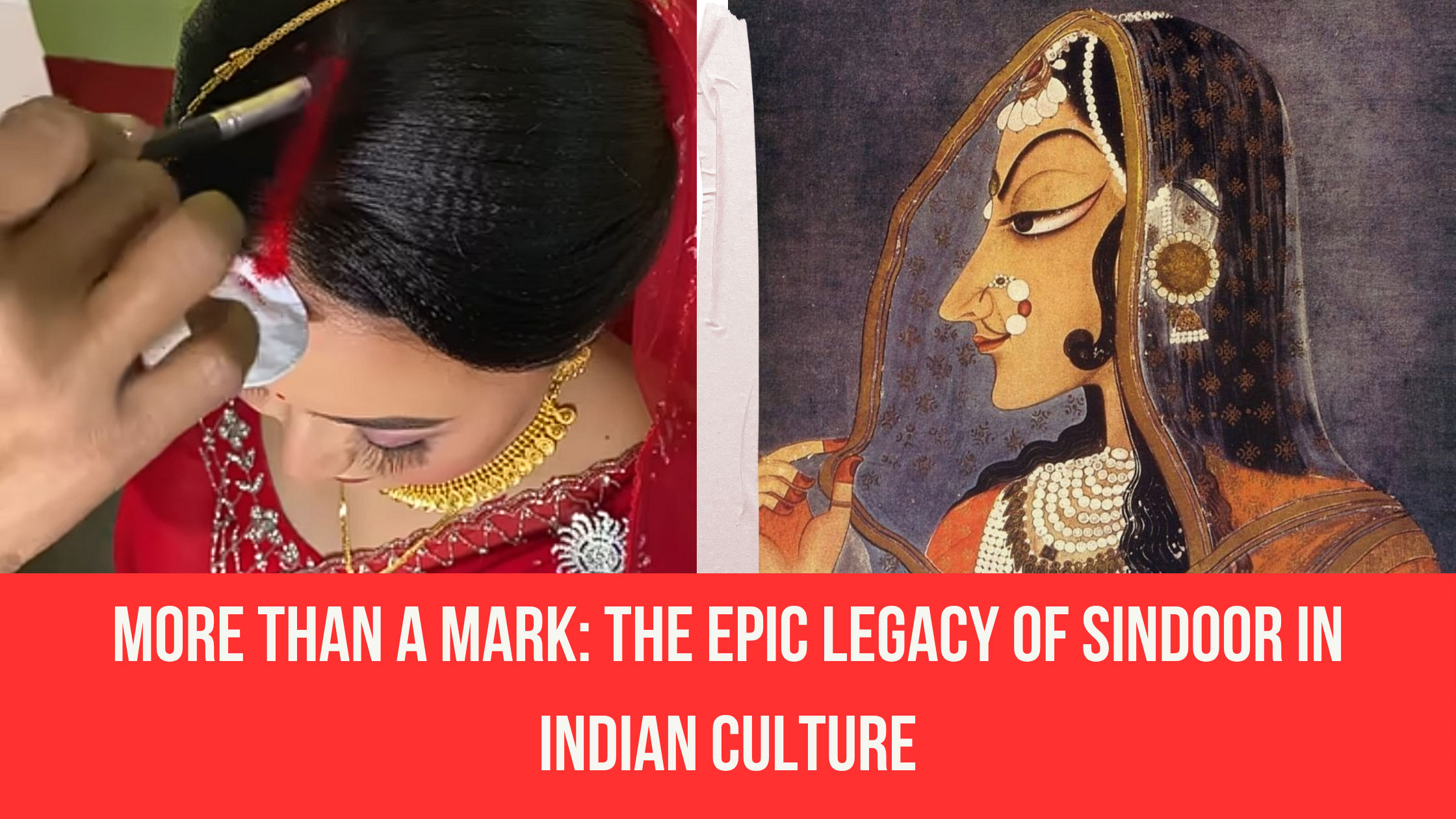When India launched its precise and powerful retaliatory strike against terror camps in Pakistan-occupied territory in May 2025, it named the mission Operation Sindoor. For many, this wasn’t just a code name—it was a powerful cultural metaphor, one rooted deeply in Indian tradition, identity, and symbolism.
What is Sindoor?
In Indian culture, sindoor (vermillion) is a sacred red powder traditionally applied by married Hindu women along the parting of their hair or on the forehead. More than just a cosmetic adornment, it signifies marital commitment, protection, and the sacred bond of family. For centuries, it has represented the well-being of husbands, the sanctity of the household, and the strength of womanhood in Indian society.
The application of sindoor on the forehead, especially at the maang (hair parting), is considered an auspicious act invoking protection and divine grace. In broader Indian tradition, the forehead itself is seen as the seat of inner power—home to the ajna chakra or “third eye,” symbolizing perception, wisdom, and willpower.
Operation Sindoor: A Name Laden with Symbolism
By naming the counter-terrorism mission “Operation Sindoor,” the Indian government invoked a powerful symbol of national protection and sacred duty. Just as sindoor is worn to safeguard the sanctity of marriage and family, this operation was designed to protect the nation’s unity, honor, and the lives of its citizens.
After the horrifying terror attack in Pahalgam, which saw innocent Hindu pilgrims brutally murdered, Operation Sindoor became India’s firm yet calibrated response—a strike that was surgical in its execution and spiritual in its essence. The mission carried out by the Indian armed forces targeted terror training camps without harming civilian or military installations—underscoring precision, restraint, and righteousness.
Sindoor as a Cultural Counter to Terror
In this context, the name wasn’t just poetic—it was ideological. Terrorism seeks to destroy peace, community, and sacred bonds. Sindoor symbolizes their preservation. It is the very antithesis of bloodshed. Operation Sindoor sent a clear message to the world: India will defend its people, its traditions, and its sovereignty with conviction—not in the name of conquest, but in the name of protection.
The Forehead as a Battlefield of Ideas
The Indian forehead, often adorned with tilak, bindi, or sindoor, has long been a symbol of spiritual awakening, cultural continuity, and divine focus. In launching Operation Sindoor, India projected that its battle against terror is not only territorial but civilizational. It’s a struggle for the right to live peacefully, practice culture fearlessly, and walk sacred paths—like those in Pahalgam—without threat.
The message was clear: India will protect its “maang”—its sacred parting—at all costs.
A Nation Adorned with Resolve
As images of mourning families and enraged citizens filled social media after the Pahalgam attack, Operation Sindoor gave India something more powerful—closure, clarity, and courage. The symbolism resonated beyond military corridors. Women wore sindoor in solidarity. Artists created posters connecting the red streak to sacrifice and strength. Thinkers noted how a cultural adornment became a national emblem of retaliation.
India didn’t just drop bombs—it dropped a message steeped in dharma: We protect what is sacred.
Sindoor as a Symbol of Sacred Defense
In naming its military response Operation Sindoor, India brought the ancient into the modern, the personal into the political, and the cultural into the strategic. The adornment of the forehead, so long a symbol of dignity and protection, was transformed into a national assertion of self-respect, sovereignty, and spiritual resilience.
Where terrorists shed innocent blood, India answered with sindoor—not as a mark of submission, but as a mark of divine justice.
Historical Significance of Sindoor in India
The tradition of applying sindoor (vermilion) in India dates back thousands of years and carries deep spiritual, cultural, and symbolic meaning. Its origins can be traced to the Vedic period (1500–500 BCE), where red-colored powders were associated with fertility, vitality, and divine protection. Although the term sindoor itself might not appear directly in the Vedas, the concept of using red pigments as symbols of auspiciousness and marital sanctity is evident. In particular, the Atharvaveda and Rigveda reference red as a life-affirming color, often linked to the well-being of the husband and family.
Epic literature such as the Mahabharata and Ramayana further solidify sindoor’s symbolic power. In the Mahabharata, Draupadi is portrayed wearing sindoor, marking her as a married woman, while Sita in the Ramayana is similarly described with traditional adornments, including the sacred forehead mark. These depictions reflect a deeper cultural association of sindoor with feminine strength, commitment, and divine grace. Moreover, goddesses like Parvati and Lakshmi are traditionally portrayed with sindoor in iconography, reinforcing its sacred status.
Archaeological discoveries from the Indus Valley Civilization (c. 2600–1900 BCE) offer some of the earliest tangible evidence of sindoor-like substances. Female terracotta figurines from Harappa and Mohenjo-daro appear with red markings on their foreheads or hair partings. Additionally, red ochre and vermilion pigments found in burial sites suggest both ritual and cosmetic use, hinting at a tradition that pre-dates written history.
Classical Sanskrit texts like the Kamasutra (circa 3rd century CE) mention the use of colored powders to adorn women, including the application of pigment on the hair parting and forehead. These acts were associated not only with beauty but also with ritual and emotional connection. Ayurveda, India’s ancient medical system, categorized sindoor as a warm substance believed to stimulate energy and protect the ajna chakra (third eye), which is considered the seat of wisdom and spiritual insight.
The importance of sindoor is also emphasized in Hindu ritual texts such as the Grhya Sutras and Dharmashastras, which detail the vivaha samskara (Hindu marriage rites). The ritual application of sindoor by the groom in the parting of the bride’s hair is one of the most sacred moments of the ceremony. It symbolizes the spiritual and social bond of marriage, invoking divine protection for the union.
During the medieval period, especially in Rajput and Mughal courts, miniature paintings and poetic works depict queens and noblewomen adorned with sindoor, reflecting status, dignity, and feminine grace. The Bhakti movement, with saints like Meera Bai and Andal, often referenced sindoor in devotional poetry, using it as a metaphor for divine love and surrender.
Across India’s diverse regions, the practice of applying sindoor continues in various forms. In North India, it is a daily ritual for married Hindu women. In Bengal, it features prominently in the Sindoor Khela ceremony during Durga Puja, where married women joyfully smear each other with sindoor as a celebration of marital harmony and goddess-like strength. In South India, similar red powders such as kumkum are used, often applied on the forehead rather than the hair parting, but with similar symbolic meanings. Even in tribal and Himalayan Buddhist communities, red markings on the forehead are used as symbols of protection, status, and spiritual power.
In summary, the history of sindoor in India is a powerful story of continuity—linking prehistoric customs with classical literature, sacred rituals, and living cultural practices. Whether seen in ancient figurines, epics, Ayurvedic texts, or modern rituals, sindoor remains a vibrant emblem of marriage, protection, feminine strength, and spiritual energy.







